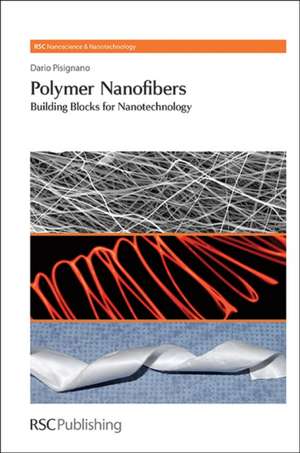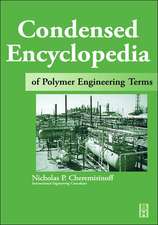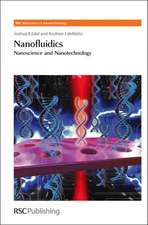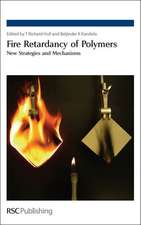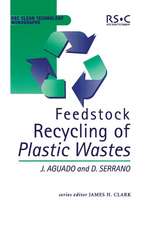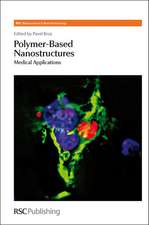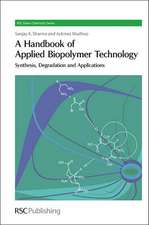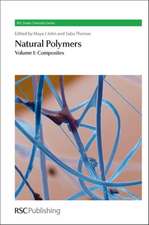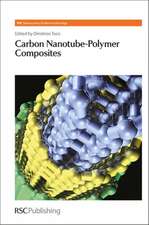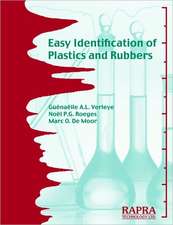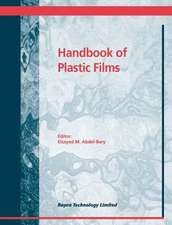Polymer Nanofibers: Building Blocks for Nanotechnology: RSC Nanoscience & Nanotechnology, cartea 29
Autor Dario Pisignano Editat de Paul O'Brien, Harry Krotoen Limba Engleză Hardback – 2 iun 2013
Din seria RSC Nanoscience & Nanotechnology
- 14%
 Preț: 943.44 lei
Preț: 943.44 lei - 14%
 Preț: 1382.07 lei
Preț: 1382.07 lei - 14%
 Preț: 1230.53 lei
Preț: 1230.53 lei - 14%
 Preț: 943.44 lei
Preț: 943.44 lei - 14%
 Preț: 778.71 lei
Preț: 778.71 lei - 14%
 Preț: 1043.67 lei
Preț: 1043.67 lei - 14%
 Preț: 1118.52 lei
Preț: 1118.52 lei - 14%
 Preț: 1204.00 lei
Preț: 1204.00 lei - 14%
 Preț: 1196.74 lei
Preț: 1196.74 lei - 14%
 Preț: 1191.46 lei
Preț: 1191.46 lei - 14%
 Preț: 1159.76 lei
Preț: 1159.76 lei - 14%
 Preț: 1157.61 lei
Preț: 1157.61 lei - 14%
 Preț: 1360.94 lei
Preț: 1360.94 lei - 14%
 Preț: 1266.87 lei
Preț: 1266.87 lei - 14%
 Preț: 1123.16 lei
Preț: 1123.16 lei - 14%
 Preț: 1353.49 lei
Preț: 1353.49 lei - 14%
 Preț: 1273.68 lei
Preț: 1273.68 lei - 14%
 Preț: 1307.70 lei
Preț: 1307.70 lei - 14%
 Preț: 1383.21 lei
Preț: 1383.21 lei - 14%
 Preț: 1386.51 lei
Preț: 1386.51 lei - 14%
 Preț: 1088.21 lei
Preț: 1088.21 lei - 14%
 Preț: 1089.02 lei
Preț: 1089.02 lei - 14%
 Preț: 682.86 lei
Preț: 682.86 lei - 14%
 Preț: 948.40 lei
Preț: 948.40 lei - 14%
 Preț: 1027.31 lei
Preț: 1027.31 lei - 14%
 Preț: 948.87 lei
Preț: 948.87 lei - 14%
 Preț: 950.05 lei
Preț: 950.05 lei - 14%
 Preț: 1102.77 lei
Preț: 1102.77 lei - 9%
 Preț: 922.81 lei
Preț: 922.81 lei - 9%
 Preț: 845.70 lei
Preț: 845.70 lei - 9%
 Preț: 1009.54 lei
Preț: 1009.54 lei - 9%
 Preț: 1110.76 lei
Preț: 1110.76 lei - 5%
 Preț: 1120.61 lei
Preț: 1120.61 lei - 9%
 Preț: 1241.51 lei
Preț: 1241.51 lei
Preț: 1242.19 lei
Preț vechi: 1444.41 lei
-14% Nou
Puncte Express: 1863
Preț estimativ în valută:
237.68€ • 248.19$ • 196.28£
237.68€ • 248.19$ • 196.28£
Carte disponibilă
Livrare economică 25 martie-08 aprilie
Preluare comenzi: 021 569.72.76
Specificații
ISBN-13: 9781849735742
ISBN-10: 1849735743
Pagini: 427
Dimensiuni: 163 x 237 x 30 mm
Greutate: 0.81 kg
Editura: Royal Society Of Chemistry
Seria RSC Nanoscience & Nanotechnology
ISBN-10: 1849735743
Pagini: 427
Dimensiuni: 163 x 237 x 30 mm
Greutate: 0.81 kg
Editura: Royal Society Of Chemistry
Seria RSC Nanoscience & Nanotechnology
Cuprins
Soft Matter Nanotechnologies; Electrospinning; Other Fabrication Technologies for Polymer Nanofibers; Structural and Surface Properties of Polymer Nanofibers and Their Applications; Optical Properties of Polymer Nanofibers and Their Applications; Electrical Properties and Their Applications; Biological Functional Properties and Their Applications; List of Acronyms; List of Symbols; Subject Index;
Textul de pe ultima copertă
The progress of research on polymer nanofibers has become especially relevant and rapid in the past couple of years. Polymer nanofibers is a hot topic, crossing many fields of nanotechnology and attracting an extremely broad audience from scientists working in different fields such as either the fabrication or the use of polymer nanofibers. This book gives a comprehensive presentation of polymer nanofibers, including both the relevant physical aspects of nanofiber formation and of their structural, superficial, optical, electrical and biological properties, and the main technological issues of methods for fabricating nanofibers, with a special focus on electrospinning. The exceptional coverage of applications in different forms, the use of interdisciplinary technical language as well as the 'from materials to applications' chapter approach, which is ideal for post-graduate students, means various interest groups including physicists, biologists, biotechnologists and engineers will find it to be an extremely valuable resource.
